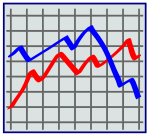Let’s say you’re having an evening out with friends, and the topic of unemployment comes up. Everyone has an opinion on how bad it is, or what the government should do about it, or if it’ll go up or down.
You’re sitting there, thinking, “I have a job, so how does the unemployment situation affect me?” You take a quick mental inventory, just to get your brain in gear (and avoid blurting out something stupid):
1. The higher the unemployment rate, the cheaper labor gets (because people are begging for jobs).
2. The higher the rate, the less pressure for minimum-wage hikes (because see #1).
3. The higher the rate, the lower the prevailing interest rates (because the government fears things will get worse unless it makes money cheaper to borrow).
4. The lower the rate, the more likely they’ll raise interest rates (because full employment leads to higher wages — labor gets hard to find and owners must offer more to attract it — which puts more money in workers’ pockets, which heats up prices, which can cause customers to cut back on purchases, which can lead to a recession, which can lead to you getting laid off).
Then you remember reading somewhere that, when the unemployment rate gets below 5%, that’s when the Fed will step in and raise interest rates. But how do they know unemployment has dropped to that number? You pull out your smartphone and Google it: the official rate used by the Fed is called “U3”, whatever that is.
Okay, “U” must mean “unemployment”, and the “3” hints at other unemployment estimates. A further search reveals that the U.S. government produces six measures of unemployment, U1 through U6, with U1 being the narrowest estimate and U6 the widest. And ooh, lookee, here’s a nice chart that shows how the various unemployment rates rise and fall in lockstep.
At this point you’re thinking, I’m gonna own this conversation.
You butt in: “Hey, it all means nothing until U-3 gets below five percent.” Heads turn. Puzzled looks. You resist the temptation to gloat. Instead you exercise regal patience: “You know, U-3, the standard unemployment rate used by the Fed to determine interest rates.” You lean back, a faint smile on your face.
Someone shakes his head. “Nah, those rates are faked up by Washington to make things look better. The real number is much higher.”
Evenly, you reply, “Yes, of course, but they also have U-6, which is a much wider estimate of unemployment.”
Someone else pipes in: “If they fake the — what did you call it?”
“U-3.”
“If they fake U-3, why won’t they fake U-6?” Heads nod.
Someone says loudly, “I never believe anything out of D.C. They’re all liars!” Cheers, high fives, glasses clinking.
This isn’t turning out the way you planned.
So next time you find yourself in this situation, here’s what to say:
“It doesn’t matter if they’re fudged numbers! They’re still useful. And the Fed relies on U-3 to make decisions whether we like it or not. So when you see the U-3 number creeping down below five percent, get ready for a change in the economy.”
If they ask, “What change?” grandly tell them:
“At that point, the Fed will raise interest rates to cool down the overheated marketplace. And this, in turn, will make it slightly harder for businesses to raise money. Which could toss a monkey wrench into the stock market.”
If they ask, “Okay, then what?” inform them:
“First, if you’re thinking of taking out a business loan, do it sooner rather than later, to keep your rate down.
“Second, if you’re holding stocks, you might want to move some of that to cash. You can shift into short-term bonds because their rates will likely rise. But long-term bonds will be stuck paying low rates, so their value will drop.”
“And third, keep an eye on U-3, because usually it gets down to the low four-percent area before the good times end and we dive into another recession.”
If they insist, “But those unemployment figures are fake!” just remind them:
“U-3 and the other U’s behave very consistently over the decades. U-6 is generally twice as high as U-3, for example, which means a U-3 of five percent translates to a U-6 of ten percent. Anyway, it’s not the number itself but how it goes up and down that counts. So don’t let your political beliefs prevent you from using the unemployment figures as bellwethers.”
(Cool word, “bellwethers”.)
Finally you declare, “Washington and the banks and big corporations pay close attention to U-3. They don’t give a damn if it’s fudged downward. They’ve heard all the theories. What matters to them is where the number is headed. So take a tip from the big boys and keep an eye on U-3.”
Then collect your well-earned applause, handshakes, thank-you’s, and offers of free drinks.
…Or not.
.

The financial intelligence is strong with this one.
LikeLike
Thanks.
(There’s a “Star Wars” joke in here somewhere, but I better quit while I’m ahead.)
LikeLiked by 1 person